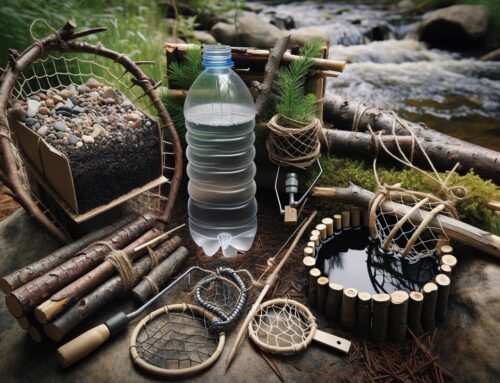A Series about Homemade Survival Gear: Crafting Essential Tools from Scratch
DIY Survival Gear, What if you had the skill to craft your own survival tools in this primal setting? Embrace this opportunity to transform raw wilderness elements into essential survival gear, connecting you deeply with outdoor survival. Let’s embark on a journey of resourcefulness and resilience, learning to craft homemade survival gear from scratch.
Key Takeaways
- Essential DIY survival gear from readily available materials.
- Simple techniques for crafting tools for food, water, fire, and shelter.
- Empowerment through self-sufficiency in survival scenarios.
Here’s what we’ll be covering in this survival series…
Table of Contents
- DIY Gear for Food and Water
- DIY Fire Gear
- DIY Fuel-Based Survival Gear
- DIY Cordage From A 2 Liter Soda Bottle
- DIY Survival Slingshot
- DIY Cigar Tube Fishing Kit
- DIY Survival Knife
- DIY Bow and Arrow
- DIY Survival Spear/Walking Stick
- DIY Solar Setup
- DIY Ranger Bands
- Frequently Asked Questions
DIY Gear for Food and Water
Surviving in the wilderness requires not just courage and resilience but also the right skills and tools, especially for obtaining food and water. This section delves into various DIY methods to ensure a consistent supply of these essentials using simple, readily available materials.
- Plastic Bottle Water Filter: Learn how to transform an ordinary plastic bottle into a life-saving water filter. This simple, yet effective method can be a game-changer in survival situations.
- Solar Still: Utilize the sun’s energy to distill and purify water. This section explains how to construct a solar still using basic materials, ensuring access to clean water in environments where water sources are scarce or contaminated.
- Water Distiller: Detailed instructions on crafting a distiller for purifying water, crucial in environments where natural water sources might be polluted or unsafe for direct consumption.
- Deer Bone Fish Hook: Discover the art of making fish hooks from deer bones or similar materials. This ancient technique can be crucial for fishing in survival situations.
- Wire or Nail Fishing Hook: A step-by-step guide to fashioning a simple yet effective fishing hook using wire or a nail, ensuring you never miss an opportunity to catch fish.
- Fish Trap: Learn to construct a fish trap using natural materials. This method is excellent for catching fish without the need for constant attention, allowing you to focus on other survival tasks.
- Survival Net: Crafting a survival net can be a multipurpose tool for fishing and trapping small animals. This section covers the basics of net-making using materials that are often found in the wild.
- Animal Traps and Snares: A guide to creating various types of traps and snares for catching small game, an essential skill for wilderness survival.
- Grasshopper Trap: A unique and often overlooked method of securing food; this part teaches you how to make a simple trap for catching grasshoppers, which can be a vital protein source.
DIY Fire Gear
Mastering the art of fire-making is crucial for survival. This section explores various DIY techniques to start and sustain a fire, which is vital for warmth, cooking, signaling, and protection in the wilderness.
- Char Cloth: An essential fire-starting material, char cloth is easy to make and incredibly effective. Learn the step-by-step process of creating char cloth from cotton fabric, a must-have for any survival kit.
- Featherstick Tinder: Feathersticks are a time-tested method of creating dry tinder, even in wet conditions. This guide covers selecting the right wood and carving techniques to create efficient feathersticks.
- Waterproof Tinder Bundle: Discover how to create tinder bundles that resist moisture, ensuring you can start a fire in damp environments. This section provides instructions on sourcing and preparing materials that stay dry and ignite quickly.
- Waterproof Matches: Sometimes, the simplest tools are the most effective. Learn how to waterproof your matches using common household items, ensuring a reliable fire source in any weather condition.
Each of these DIY fire gear methods emphasizes simplicity and effectiveness, using materials that are often readily available in nature or can be prepared with minimal tools. By mastering these techniques, you can significantly increase your survival chances and comfort in the wilderness.
DIY Fuel-Based Survival Gear
This section delves into innovative ways to create survival gear that utilizes various fuels for heating and cooking. It includes designs like the Hobo Stove, crafted from a tin can for portability and ease of use. The Rocket Stove, known for its efficiency, makes use of small wood pieces, reducing fuel consumption. Other gear such as Soda Can Solar Heaters and Alcohol Stoves are covered, showcasing how everyday items can be repurposed for survival needs. This section is crucial for anyone looking to sustain themselves in the wild with minimal resources, emphasizing ingenuity and practical skills.
- Hobo Stove: Crafted from a large tin can, it’s an easily made portable stove, ideal for cooking and heating.
- Rocket Stove: Utilizes small wood pieces in an efficient combustion chamber, providing intense heat with minimal smoke.
- Soda Can Solar Heater: A creative use of aluminum cans, painted black and arranged in a panel to capture and convert solar energy into heat.
- Alcohol Stove: Made from aluminum cans, it’s lightweight and efficient, burning denatured alcohol as fuel.
- Wood Gasifier Stove: A more complex stove that burns wood while producing wood gas, leading to cleaner and more efficient combustion.
- DIY Oil Lamp: Utilizing common household materials like oil, a wick, and a jar or can for a reliable light source.
- CFV Stove: A Can, Foil, and Votive candle stove, simple to make and useful for heating small spaces.
- Wind Screen for Canister Stove: Improves efficiency and safety of portable gas stoves by shielding them from wind.
- DIY Candles: Using wax and wicks, these can be made for lighting and minimal heat.
- Solar Charger: Harnessing solar power to charge small devices, crucial in off-grid situations.
DIY Cordage From A 2 Liter Soda Bottle
“DIY Cordage From A 2 Liter Soda Bottle” involves creating strong, versatile cordage from an empty plastic soda bottle, a resourceful way to repurpose waste. The process begins by cutting the bottle into a continuous thin strip, spiraling from top to bottom. This strip is then stretched, which both thins and strengthens the plastic, transforming it into a durable cord. This homemade cordage can be used in various survival scenarios, from building shelters to makeshift fishing lines, showcasing an innovative approach to using everyday items in survival situations.
- Material Collection: Start with an empty 2-liter plastic soda bottle.
- Cutting the Bottle: Use scissors or a knife to cut the bottle into a continuous thin strip, creating a plastic ribbon.
- Making the Cordage: Stretch the plastic strip to thin it out, increasing its strength and length.
- Usage: This cordage can be used for tying, lashing, or even as a makeshift fishing line.
- Storing: Roll the cordage for compact storage in a survival kit.
This DIY project turns waste into a valuable survival resource, emphasizing resourcefulness and sustainability.
DIY Survival Slingshot
A DIY Survival Slingshot is a versatile and compact tool that can be a valuable addition to your survival gear. Whether you’re an outdoor enthusiast, a prepper, or just someone looking for a fun and practical project, crafting your own survival slingshot can be an exciting and rewarding endeavor.
- Base Selection: Start with a Y-shaped branch or a sturdy piece of plastic for the slingshot frame.
- Elastic Band: Use rubber bands, elastic from old clothing, or inner tube strips for the slingshot’s tension mechanism.
- Attachment: Securely attach the elastic to the Y-shaped frame using knots, glue, or tape.
- Pouch: Fashion a pouch from leather, cloth, or durable plastic to hold projectiles.
- Ammunition: Use small stones, metal balls, or homemade clay pellets.
This DIY slingshot is not just a hunting tool but also a practice in resourcefulness and adaptability, key traits for survival.
DIY Cigar Tube Fishing Kit
A DIY Cigar Tube Fishing Kit is a compact and ingenious tool that allows you to carry a basic fishing setup conveniently in a repurposed cigar tube. Whether you’re an angler on the go, an outdoor enthusiast, or someone looking to assemble a minimalist fishing kit for emergencies or leisure, this project can be both practical and fun.
Materials Needed:
- Cigar Tube: You can use an empty, cleaned, and dry cigar tube for this project. Choose one that’s large enough to hold your fishing gear comfortably.
- Fishing Line: Select a suitable fishing line, typically monofilament or braided line, and spool it onto a small reel or plastic spool.
- Fishing Hooks: Include a variety of hooks in different sizes and types, such as J-hooks, circle hooks, and treble hooks.
- Fishing Lures: Add a few fishing lures or soft plastic baits to attract fish. Choose lures that are versatile and suitable for a range of fish species.
- Weights or Sinkers: Include split shot sinkers, bullet sinkers, or other types of weights to help your bait sink to the desired depth.
- Bobbers or Floats: Pack a couple of small bobbers or floats to help detect bites and keep your bait suspended at the right depth.
- Swivels and Snap Clips: Include a few swivels and snap clips to prevent line twists and make it easier to change lures or hooks.
- Needle or Safety Pin: You’ll need a needle or a safety pin for threading the fishing line through small spaces or securing knots.
- Small Pliers or Multi-tool: To handle hooks, crimp weights, and perform basic tackle maintenance.
DIY Survival Knife
A DIY Survival Knife is a versatile and essential tool for anyone who spends time in the great outdoors, whether for camping, hiking, or emergency preparedness. Crafting your own survival knife allows you to create a personalized and reliable tool that suits your needs and preferences.
Materials Needed:
- Steel Blade Blank: Choose a high-quality steel blade blank with the desired size and shape for your survival knife. You can purchase blade blanks online or from specialty knife-making stores.
- Handle Material: Select a material for the knife handle, such as wood, Micarta, G-10, or antler. The choice of handle material should be based on your grip preferences and the knife’s intended use.
- Epoxy or Adhesive: To bond the blade to the handle securely.
- Pins or Rivets: For attaching the handle scales to the blade securely.
- Sandpaper or Abrasives: Various grits, from coarse to fine, for shaping and finishing the blade and handle.
- Clamps: To hold the handle scales in place while the epoxy dries.
- Files and Rasps: For shaping the handle and blade.
- Drill and Drill Bits: To create holes for the pins or rivets.
- Saw: For cutting and shaping the handle material.
DIY Bow and Arrow
Creating your own DIY bow and arrow is a fascinating project that allows you to craft a functional weapon and tool for hunting, target practice, or survival situations. While making a bow and arrow from scratch can be challenging, it can also be a rewarding and educational endeavor.
Materials Needed:
For the Bow:
- Wooden Stave: Select a straight and dry wooden stave or branch, ideally from a hardwood tree like oak, hickory, or maple. The length should be approximately your height or slightly shorter.
- Twine or Cordage: You’ll need a strong cordage made from natural fibers like hemp, jute, or paracord.
- Knife or Hatchet: For shaping the bow.
For the Arrows:
4. Wooden Shafts: Choose straight and dry wooden dowels or branches for the arrow shafts. Cedar, birch, or pine are suitable options.
- Arrowheads: You can create arrowheads from materials like flint, obsidian, or metal. Alternatively, you can use store-bought arrowheads.
- Fletching: Use feathers, plastic vanes, or other materials for the fletching (the feathers or fins at the back of the arrow).
- Nocks: Carve nocks into the rear end of the arrow shafts to attach the bowstring.
- Glue or Pitch: For securing the arrowheads and fletching.
DIY Survival Spear/Walking Stick
A DIY Survival Spear/Walking Stick is a versatile outdoor tool that combines the functionality of a walking stick for support and balance with the utility of a spear for various survival and self-defense purposes. Crafting your own survival spear/walking stick is not only a practical endeavor but also an opportunity to personalize your gear to suit your specific needs.
Materials Needed:
- Long, Straight Stick: Choose a sturdy, straight stick that is approximately shoulder height or slightly taller when standing.
- Blade or Spearhead: You can either buy a pre-made spearhead or craft one from a suitable material such as metal, bone, or stone. The blade should be sharp and durable.
- Cordage: Strong cordage or twine for binding the blade securely to the stick.
- Knife or Saw: For shaping and preparing the stick and spearhead.
- Sandpaper or Abrasives: To smooth and finish the wooden stick and the spearhead.
- Drill and Drill Bits: For creating holes for the blade attachment.
- Fire-Starting Materials: A fire starter or waterproof matches for emergency fire-making.
DIY Solar Setup
Creating your own DIY solar setup is a fantastic way to harness the power of the sun for electricity generation, whether for your home, cabin, RV, or other remote applications. Building a solar power system can be a complex project, but with careful planning and the right components, you can generate clean, renewable energy.
Components Needed:
- Solar Panels: These photovoltaic (PV) panels convert sunlight into electricity. The number of panels you need depends on your energy requirements.
- Mounting Hardware: To secure the solar panels in a location with optimal sun exposure, such as a rooftop, ground mount, or pole mount.
- Solar Charge Controller: This device regulates the power generated by the solar panels and ensures that your battery bank is charged efficiently. It prevents overcharging and extends battery life.
- Deep Cycle Batteries: These are essential for storing excess energy generated during sunny days for use during periods of low or no sunlight.
- Power Inverter: Converts the direct current (DC) electricity stored in the batteries into alternating current (AC) electricity, which is what most household appliances and devices use.
- Wiring and Cables: You’ll need appropriate cables, wires, and connectors to connect all the components together.
- Fuses and Breakers: These provide protection for your system by preventing overcurrent and electrical faults.
- Mounting Structures (if not included): If your solar panels don’t come with mounting structures, you may need to purchase or fabricate them.
- Tools: Standard hand tools, such as wrenches, screwdrivers, wire cutters, and a drill, are necessary for installation.
DIY Ranger Bands
DIY Ranger Bands are versatile, durable, and simple-to-make bands that have a wide range of uses in outdoor activities, survival situations, and everyday life. They are typically made from recycled bicycle inner tubes and are excellent for securing gear, organizing items, and providing friction or grip in various situations.
Materials Needed:
- Bicycle Inner Tubes: You can usually find discarded or old bicycle inner tubes at bike shops or repair centers. Make sure they are clean and free from major punctures or tears.
- Scissors or Sharp Knife: For cutting the inner tubes into bands.
Frequently Asked Questions
Additional Reading
- For more insights on multi-functional survival tools, check out our Top 5 Multi-Use Survival Tools.







Leave A Comment